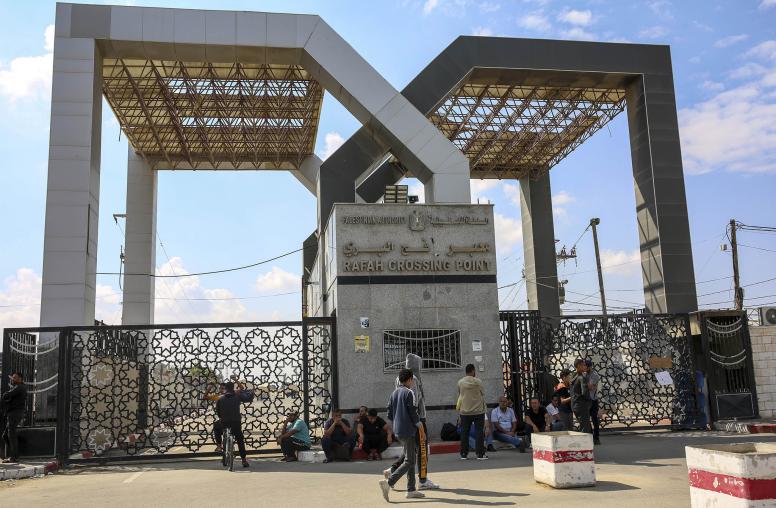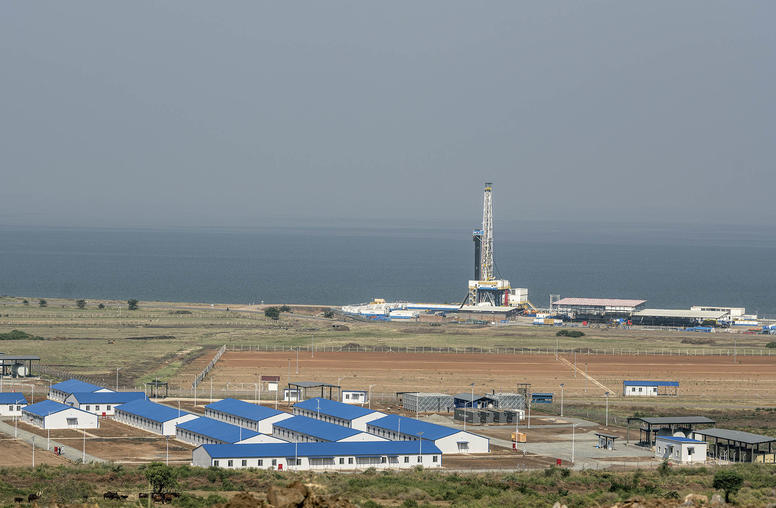Takeaways from Blinken’s Trip to the Middle East
The Middle East again shows it can draw U.S. attention. But will U.S. policy change from “firefighting” to proactive statecraft?
The Middle East has not been a high priority for the Biden administration thus far, with issues such as Russia’s war in Ukraine and escalating tensions with China taking precedence. However, recent developments in the region are catching the administration’s attention, and Secretary of State Antony Blinken’s visit to Egypt, Israel and the West Bank earlier this week sought to reaffirm U.S. engagement in the Middle East amid political turnover in Israel, spiraling violence in the Israeli-Palestinian arena, stepped-up Iran-Israel tensions and a deepening economic crisis in Egypt.

USIP’s Lucy Kurtzer-Ellenbogen, Hesham Youssef, Robert Barron, Garrett Nada and Caroline Dibble address the key messages and takeaways from Secretary Blinken’s trip and the implications for the administration’s approach to the Middle East going forward.
Secretary Blinken’s first stop was in Cairo. What messages did the administration bring, and what can we discern about U.S. posture and priorities in the bilateral relationship with Egypt?
Caroline Dibble: Secretary Blinken kicked off his four-day tour of the Middle East in Egypt where he delivered two key messages on behalf of the Biden administration: First, the United States continues to view Egypt as a key actor in maintaining regional stability. And second, the United States is increasingly concerned by the prospect of Egypt’s economic collapse and the implications for the region.
Amid a fifth day of violence in Jerusalem and the West Bank, Blinken described Egypt’s role in preserving regional stability as “critical — maybe even more critical than it’s ever been,” in a joint statement with Egyptian Foreign Minister Sameh Shoukry.
The United States and Egypt have continuously emphasized their shared commitment to a two-state solution, and Egypt has played a consistent role in de-escalating flare-ups in the Israeli-Palestinian conflict — the Gaza cease-fire in July 2022 being the most recent instance. President Abdel Fattah al-Sisi and Israeli President Benjamin Netanyahu are known quantities to each other and utilizing this pre-established channel of communication will be a priority for the United States, both to contain the current situation and push for a negotiated peace process based on the principles of a two-state solution.
With regional stability at the foundation of the U.S.-Egypt strategic partnership, the Biden administration has placed new emphasis on economic cooperation out of concern for Egypt’s internal stability. Blinken’s visit comes just over a month after Egypt and the International Monetary Fund’s most recent attempt — their fourth deal in the last six years — to salvage the Egyptian economy and encourage private sector investment.
As the already-fragile Egyptian pound plunges to record-lows, with the additional strain of global shocks like COVID-19, global inflation and grain shortages due to the war in Ukraine, Blinken’s visit serves as a reminder to Egypt that it’s in its best interest — as well as that of the region — to make-do on promises of economic reform and private sector investment.
Secretary Blinken visited Jerusalem and Ramallah amid deteriorating violence. How did this impact the agenda, and will we see the United States once again drawn into the role of mediator?
Lucy Kurtzer-Ellenbogen: Secretary Blinken’s trip was planned before the most immediate escalation in Israeli-Palestinian violence, yet the negative trendlines have been clear. The Biden administration is no stranger to this arena, and so the context that greeted Blinken and his team was undoubtedly unwelcome, but not a surprise.
Questions now turn to the administration’s calculus of whether its firefighting approach of the past is enough to meet the challenges of the present, as well as the goal it has set for the future: “Equal measures of freedom, security, opportunity, justice, and dignity” for Palestinians and Israelis, ideally achieved through “two states for two peoples.”
From the outset of the trip, this vision seemed far removed from the dire reality unfolding on the ground. 2022 was the deadliest year for Palestinians and Israelis at each other’s hands in decades. The occupation is entrenching with extremist annexationist ministers wielding significant power in the Israeli government, while Palestinians remain divided and under two sets of authoritarian rule.
The West Bank leadership under President Abbas has lost legitimacy, and with it any semblance of control it once had over significant parts of the West Bank, where militancy is strengthening. Major death tolls from last week’s deadly Israeli army raid targeting Palestinian militants in a Jenin refugee camp, and from a subsequent terror attack by a Palestinian man on Israelis in East Jerusalem, suggest that 2022’s violence could be merely a sign of things to come.
The administration is under no illusions. It knows that shifting this reality to get back on the road to a diplomatic solution is a Herculean task, and one requiring significant expenditure of political and diplomatic capital.
Their cost-benefit analysis is clear. Assessing that the trends and realities on both sides don’t augur for success, the administration has inclined toward conflict containment over the heavy and leverage-wielding task of resolution: De-escalation, preserving potential for the end goal as much as possible, and making room for pursuit of more pressing or promising interests are now the Biden administration’s guiding principles.
In the latter vein, Blinken placed strikingly clear emphasis on the administration’s concerns about Israeli democratic backsliding under the new government. On the topic of foreign policy priorities, the regional threat from Iran and the expansion of the Abraham Accords were high on both Blinken’s and Netanyahu’s agenda, prevalent in both leaders’ public talking points, and undoubtedly in their private conversations.
At the same time, the administration appears intent on signaling that refraining from proactive diplomacy does not mean ignoring the situation entirely. While Netanyahu focused his public remarks almost entirely on Iran and expansion of the Abraham Accords, adding an almost token line that the latter could ultimately help resolve relations with the Palestinians, Blinken took the opportunity to fill in the blanks. He affirmed the importance of both issues, while noting that relationships with other Arab states is not a substitute for Israeli-Palestinian progress and that maintaining the Status Quo arrangement at the Temple Mount/Haram Al Sharif is crucial — reminding Prime Minister Netanyahu (and the public audience) that Netanyahu himself has repeatedly committed to do so.
In Ramallah, Secretary Blinken focused on U.S. efforts to “rebuild [the] relationship with the Palestinian people and the Palestinian Authority,” and urged improvement of governance, accountability and the strengthening of Palestinian Authority institutions.
In a culminating press conference, Blinken offered a list of actions that the administration believes run counter to its vision of two states, and therefore opposes, with most balls in Israel’s court: “Including but not limited to settlement expansion, legalization of illegal outposts, a move towards annexation of the West Bank, disruption to the historic status quo on Jerusalem’s holy sites, demolitions and evictions, and incitement and acquiescence to violence.”
If the devil is in the details, with this administration, those details have often been in the subtle discursive nuances. Amid the flammable dynamics of the moment, and the longer-term structural drivers of which they are a symptom, signals and implicit warnings may only go so far to quench the flames.
Still, Secretary Blinken left no doubt that the United States sees itself as a willing partner, but not firefighter-in-chief. Noting that he was keeping senior U.S. officials on the ground to continue discussions on de-escalation, he added that any further steps taken will be ones in which the “parties themselves must lead ... We’re prepared to support efforts here and with partners in the region if the parties have the will to do so.”
The administration no longer sees two states as the goal itself, but rather views “equal measures of freedom, security, opportunity, justice, and dignity” as the goal, achieved ideally through a two-state solution.
It’s a subtle shift, but one that indicates the Biden administration is cognizant that the two-state solution may not be the only option — at least not for much longer. The implicit message seems to be that the Biden administration has put down their end-goal marker and has certain expectations for achieving it. The administration can’t and won’t turn away, but neither will it necessarily save the parties from themselves, or each other.
What role did evolving U.S. policies toward Iran play in Secretary Blinken’s trip to the region?
Garrett Nada and Robert Barron: In November, President Biden offhandedly said that talks to revive the 2015 nuclear deal with Iran were “dead,” but added that the United States would not announce it officially.
In the meantime, Washington has shifted its focus from negotiations over Iran’s nuclear program to the Iranian regime’s brutal crackdown on domestic protests and military support for Russia’s war on Ukraine.
President Biden has faced pressure, at home and abroad, to do more to contain Iran’s nuclear program, as Tehran continues to stockpile more enriched uranium which could be used to fuel a nuclear weapon. Blinken’s visit was part of a wider effort by the White House to coordinate with Israel’s new government that took office in December. He was the third senior U.S. official to visit Israel in January, as National Security Advisor Jake Sullivan and CIA Director Bill Burns had already made separate trips.
During Blinken’s visit to Israel this week, Iran was one of the most important topics on the agenda. The secretary reaffirmed the “ironclad” U.S. commitment to Israel’s security at a press conference with Netanyahu: “We agree that Iran must never be allowed to acquire a nuclear weapon, and we discussed deepening cooperation to confront and counter Iran’s destabilizing activities in the region and beyond.”
In the same press conference, Netanyahu told Blinken that his visit came at a time when “many in the international community … have seen the true face of Iran,” referring to Iran’s crackdown on domestic protests and export of armed drones to Russia for use against Ukraine.
Blinken’s trip also followed at least three strikes on Iran and its proxies and came less than a week after the largest ever U.S.-Israeli military exercise — with the live-fire drill read as an implicit show of force to Tehran.
Overall, prospects for a revival of the JCPOA seem dim, and the Biden administration has stated its intention to maintain and increase sanctions and rein in other Iranian maneuvering, such as drone sales to Russia and oil sales to China.
The Biden administration has also emphasized — despite other areas of policy friction — the value it places on the U.S.-Israel relationship as it relates to the Iranian threat. As the kaleidoscope of rivalries and flashpoints continues to change, the Islamic Republic represents a complex challenge for the administration. Coordination with regional allies like Israel is central to the U.S. strategy.
For some time, many regional allies have viewed the United States as in retrenchment from the region. Did this trip do anything to shift that perspective?
Ambassador Hesham Youssef: The perception by regional allies of U.S. retrenchment has been growing gradually over the years. It doesn’t relate specifically to the Israeli-Palestinian conflict, which the region recognizes has its own complex dynamics. But the first major signal was the Obama administration’s flouting of its own redline in Syria, where it took a step back at a time when the region expected decisive action from the United States.
This perception deepened under the Trump administration, when the Houthis attacked Saudi oil fields in 2019. While then-Secretary of State Mike Pompeo declared the attack “an act of war” on Saudi Arabia and “of a scale we've just not seen before,” the U.S. response ended there. Cut to the Biden administration in 2022, when the Houthis again struck, this time at oil tankers near Abu Dhabi airport: The UAE complained that the United States did not call for three weeks after the attack.
President Biden took a first step to change that perception in his statement before the GCC+3 Summit in Riyadh in 2022, indicating that the United States will turn its attention and resources to supporting its partners, strengthening alliances and building coalitions to solve the problems facing this region. He added that U.S. objectives are focused, realistic and achievable so that it can target its resources, rebuild trust and deliver real results. However, the perception in the region is that no effective dialogue or follow-up was pursued.
The lack of an effective U.S. role in addressing the Israeli-Palestinian conflict reinforces the perception of U.S. retrenchment but is not the only litmus test in relation to the U.S. role in the region. This is why the latest trip by Secretary Blinken to the region did not contribute to shifting this perception, but rather sends the message that U.S. retrenchment continues.
As mentioned above, Iran was an important issue on the agenda in Israel, though the outcome of this discussion was not revealed. However, the balance in the U.S. approach between the interests of Israel and the Gulf states in this regard, and how it is conveyed to the latter, will be significant in ameliorating relations with those key U.S. allies in the region.



